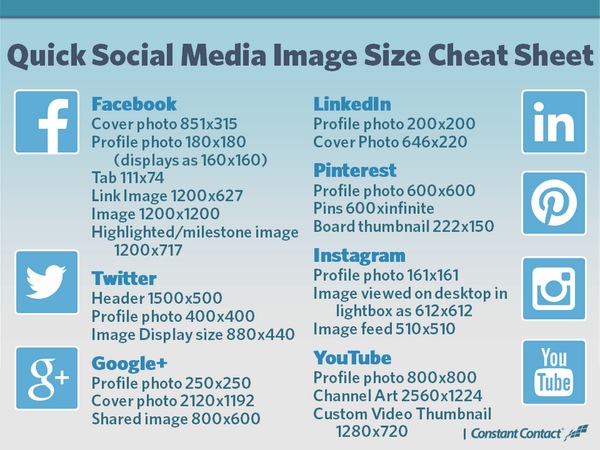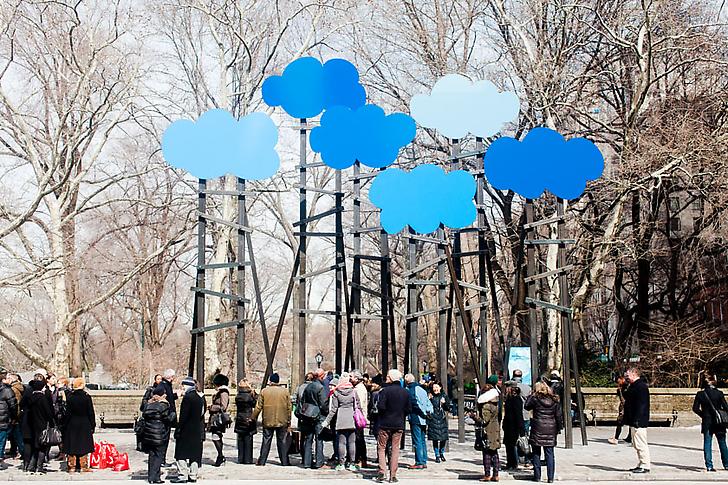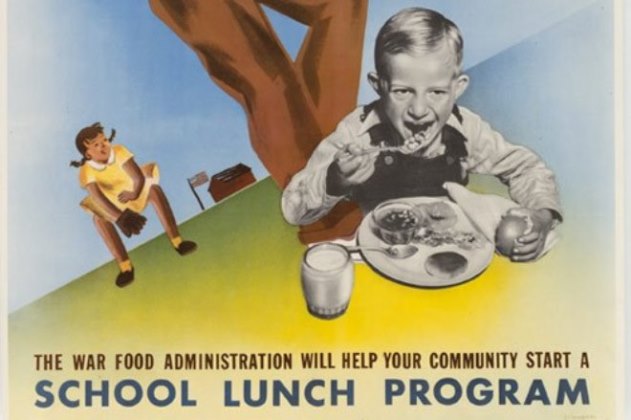Very often I find quick reference cheat sheets and guides to help me in the world of Social Media. Our friends at Constant Contact recently shared this handy guide. Enjoy!
Political Polarization in the American Public
Collaboration and communication were once fundamental virtues in politics and government. It was how democracy worked. People would run for office on a specific platform. If they were successful, they would be called on to work with other successful politicians, many elected on platforms that often differed in terms of priorities and even the role of government. But somehow, through collaboration, they would get beyond their differences and find common ground to address what were considered important public issues.
Along the way, this spirit of collaboration and compromise, where people were willing to put water with their wine and when they didn't make perfect the enemy of the good, has been hard to find in politics and government. Politics has become a fight to the death, where compromise is a dirty word and working together is seen as collaborating with the enemy.
It's not surprising, then, to read the recent Pew Research study Political Polarization in the American Public (http://www.people-press.org/2014/06/12/political-polarization-in-the-american-public/) that found the U.S. population is more divided on partisan and ideological grounds than ever.
The result is that people themselves have become more entrenched in their opinions and less willing to see the other side of the argument. The question is what came first, the chicken or the egg - are politicians merely reflecting public opinion, or has hardball politics created a more divided population? Whatever the case, it's not healthy for either democracy or governing.
It's time to make collaboration a virtue again.
Photo credit: http://womenspost.ca/wp-content/uploads/2013/08/democracy.jpg
Win Mega Millions with Design
Design dictates the environment at every workplace, from the way a company carries out day-to-day business, to the look and feel of the environment, which all together can manifest mega-millions. And to some degree an investment in design can be a lottery. Anyone who really wants to win, “mega-millions” needs to play the game, i.e. invest in design. With design at the forefront of many “mega-million” companies, like Apple it’s only obvious to see that design is a critical component of success. Success, at the least, meaning a company meets a revenue goal or above or makes a profit. Design that is successful, is carried across to user experience, to being agile and playing the “Powerball” by incorporating design strategy. When design strategy works it’s seen by everyone, for example, Uber the ride sharing service. Design creates efficiency, on top of making things look pretty, it also delivers competitive advantage, increased productivity and “mega-millions” if you do it right.
Those doing it right are: Apple, Coca Cola, Ford, Herman-Miller, IBM, Intuit, Newell-Rubbermaid, Nike, Procter & Gamble, Starbucks, Starwood, Steelcase, Target, Walt Disney and Whirlpool.
These companies set out to get the mega-millions and won. The simplest of rules are don’t get distracted with the traditional strategies, look further out than the current trends (check out the Mike Stemple ICOSA article, he is a genius at this), customize each client and offer a collaborative strategy.
However, it is not always about monetarily winning, but about continued success. Making design your capital asset will keep your business on track to be or continue in success. Janette Sadik-Khan, NYC transportation commissioner works to design the city and the city streets. She spoke at TED about her work. The best advice can be taken from Khan, and the success of the astonishing Times Square design. Watch the video below to see NYC transform over the years to accommodate growth.
As half the year is now over, it’s time to start breaking out those projections and incorporating design strategies for next year.
Google the Best Version of You
Admit it, you've Googled yourself. It was either embarrassing or illuminating, wasn't it? For some people it may be horrifying. Embarrassing photos, haunting news items, perhaps stuff they wouldn't want a potential employer or potential date, to see. But how can you scrub the internet? Well, so far, in the U.S. you can't, but in the EU it is an option. European Union courts recently made a landmark ruling requiring Google to allow for "the right to be forgotten". It gives ordinary citizens a chance to distance themselves from negative results when someone Googles their name. This doesn't mean that any and all unsavory information is just removed from the internet. Rather, an individual must make a formal request using an online interface. Currently, there's a tremendous backlog. According to an Inc.com article, there were 12,000 requests the first day, up to twenty requests per minute.
Each request is assessed on it's own merit. As of yet, there is no word from the company on the percentage of complaints that meet the court specifications for potentially objectionable, which are "inadequate, irrelevant or no longer relevant."
Some say such gentrification of internet searches amounts to censorship, and may lead to public officials and criminals eliminating or hiding unfavorable information from the public, but that is not the intent of the ruling, as the basis is relevancy. Additionally, the guidelines that Google has set up, would display a notice that some information has been removed due to privacy considerations.
And to be fair, they are only in control of what comes up in Google searches. You're on your own when it comes to other search engines.
One can only imagine the intricacies of determining what is proper, what can reasonably be removed, what pieces of everyone's life that the public has a right to know. Even harder to imagine the same ruling getting thoughtful consideration here in America. For now, we all have to continue to be careful about what we post as public information.
Do you really want to post that #selfie?
Getting to We
Often in business deals, the focus is on getting the most you can, for the least amount of sacrifice. Allegiances and goodwill are usually victims in that strategy, even when both parties work to meet in the middle. What is needed is a completely different view on negotiation to do better.
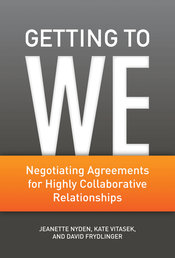 Jeanette Nyden calls it a new negotiation paradigm. In her book, Getting to We - Negotiating Agreements for Highly Collaborative Relationships, which she co-authored with Kate Vitasek and David Frydlinger, Nyden referrs to a five-step process to negotiation, all at the heart of WIIFWe (What's In It For We).
Jeanette Nyden calls it a new negotiation paradigm. In her book, Getting to We - Negotiating Agreements for Highly Collaborative Relationships, which she co-authored with Kate Vitasek and David Frydlinger, Nyden referrs to a five-step process to negotiation, all at the heart of WIIFWe (What's In It For We).
Rather than looking at each deal individually, as in "this time", Getting to We encourages building a relationship with those with whom you do business. No contract is a one time deal, you should be planning to work together, to facilitate the sort of agreements where there is not one clear winner, but both parties meeting on the same line, willingly.
Jeanette is a captivating speaker and an absolute delight to interview. We have a lot of fun on this week's program, so tune in to learn the new art of negotiation - and enter to win a copy of her book!
Connect & Collaborate with ICOSA is giving away twenty copies of Getting to We. Just submit your name in our entry form below, LIKE our Facebook page at www.Facebook.com/ICOSARadio, and share the contest with your friends. On Monday morning we'll draw twenty winners from the entries and let you know if you won. Listen to the podcast of this program by clicking below. You can play right here, or download our iPhone app at connectcollaborate.podbean.com/mobile/
The Outernet
While scrolling through my Facebook news feed I was intrigued by this graphic. This is a great visual representation of social media and how we've done this for years just in a different view point before social media. This was created in 2012 by John Atkinson, Wrong Hands. To learn more about this graphic please visit: http://wronghands1.wordpress.com/2012/03/01/the-outernet/
Drone Delivery Knocked Down
If you're expecting an Amazon order to come directly to your door via drone, it's time to lower your expectations. The FAA shot down approval for drone delivery, in a DOT request for comment document. While Amazon Prime Air isn't mentioned specifically in the document, the decision clearly limits drone use for hobby and recreation.
"Clearly, commercial operations would not be hobby or recreation flights," said the FAA report. "Likewise, flights that are in furtherance of a business, or incidental to a person’s business, would not be a hobby or recreation flight."
The wording would seem to knock down drone use for other commercial purposes as well, including aerial photography for real estate or other commercial production.
This may not be the final word on the issue. The notice of interpretation with request for comment opens the issue to a period of public consideration. The FAA will receive comments from interested parties on this decision before procedding. If you would like to add your comments, you'll find guidelines for doing so within the report linked here.
Those Notorious Clouds - Denver & Beyond
Clouds by Olaf Breuning is an installation at the corner of 60th Street and 5th Avenue, Central Park, NYC. Each year I look for cloud installations to remind me to keep looking up, because the sky is the limit (yes I find cheesy cliches to be funny). Breuning’s Clouds were at last week’s Art Basel in Switzerland, on what looked like a miniature scale, as you can see people about the same height as the clouds. Now everyone knows if your work is showing at Basel you are the cat’s meow, as Basel brings in an outstanding quality of artwork and attracts collectors and museums internationally. Basel is the premier global art show, which brought in 92,000 attendees over a six day show.
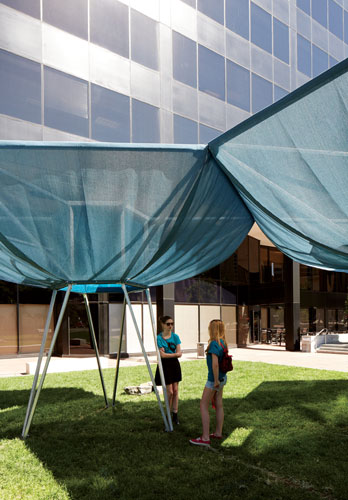 I think of the many artists I admire, and the how they incorporate objects representing nature and place them into unpredictable areas. Last year 2013, I was impressed with Skyline Cloud by plan:b arquitectos for their utilitarian purpose and design. Skyline Cloud was commissioned by the Biennial of the America’s, which will be in Denver next year, 2015.
I think of the many artists I admire, and the how they incorporate objects representing nature and place them into unpredictable areas. Last year 2013, I was impressed with Skyline Cloud by plan:b arquitectos for their utilitarian purpose and design. Skyline Cloud was commissioned by the Biennial of the America’s, which will be in Denver next year, 2015.
Click Here To Watch on Vimeo.
Skyline Cloud by Plan:b architects Draft Urbanism / Biennial of the Americas 2013 Curators: Paul Andersen / Carson Chan / Gaspar Libedinskyfilmed and directed by Cristobal Palma edited by Francisco Jullian music by Sebastian Vergara © 2013, Estudio Palma
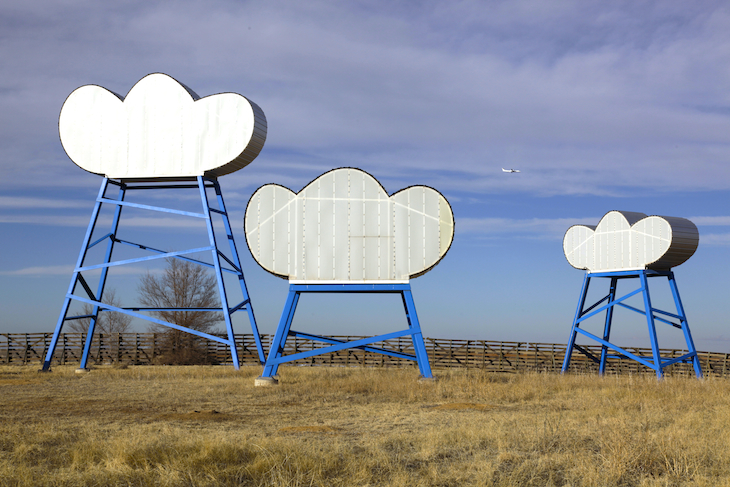
Another notorious cloud installation, in Denver is seen by all travelers coming to Denver via Denver International Airport. Cloudscape by Christopher Lavery has been recognized by the Public Art Network as one of the top sculptures installed in 2010. DIA explains, “The clouds, which are hollow structures made of corrugated metal and cellular plastic, range in size from 16 to 40 feet, and are mounted on a steel base along the western side of outbound Peña Boulevard to greet people arriving in the Mile High City. Lavery took his inspiration for the sculpture from Colorado's vivid sky and sunsets.”

Olaf’s cartoon-like Clouds beg the question why? Why here? Why clouds? Is it a disruption from the norm? Or just for fun? I took a look at the website; publicartfund.org to find out more. Here is what I found:
Olaf Breuning’s installation, Clouds, towers nearly 35 feet above this plaza. Held aloft among the trees of Central Park by rudimentary steel supports, the six bright blue clouds are made of polished and painted aluminum and were cut to match a hand drawing by the artist. Calling to mind the set design of a school play or child-like drawings of the sky, the idea for this work is inspired by one of the artist’s staged photographs. For this earlier work, Breuning used cranes and cherry pickers to raise large blue drawings of clouds high in the air, creating a momentary scene to be captured by the camera.
Interested in situations that bend reality to the whims of his imagination, Breuning’s forays into film, sculpture, drawing, and photography often propel viewers into a world that borders on the surreal and underscores the humor of everyday life. Clouds dramatically transforms the skyline of the park into a playful fictional tableau, inviting us to experience the stage-like quality of a New York City street with a new sense of wonder and possibility.
Have you seen any other public works of art that are similar to Clouds? If so please post them on my Facebook or Twitter.
20 Common Grammar Mistakes That (Almost) Everyone Makes
Very often I find myself questioning my writing and more importantly my grammar. The article was originally posted by Jon Gingerich on January 31, 2012 and has helped me in countless ways and is definitely worth a reshare. Who and Whom This one opens a big can of worms. “Who” is a subjective — or nominative — pronoun, along with "he," "she," "it," "we," and "they." It’s used when the pronoun acts as the subject of a clause. “Whom” is an objective pronoun, along with "him," "her," "it", "us," and "them." It’s used when the pronoun acts as the object of a clause. Using “who” or “whom” depends on whether you’re referring to the subject or object of a sentence. When in doubt, substitute “who” with the subjective pronouns “he” or “she,” e.g., Who loves you? cf., He loves me. Similarly, you can also substitute “whom” with the objective pronouns “him” or “her.” e.g., I consulted an attorney whom I met in New York. cf., I consulted him.
Which and That This is one of the most common mistakes out there, and understandably so. “That” is a restrictive pronoun. It’s vital to the noun to which it’s referring. e.g., I don’t trust fruits and vegetables that aren’t organic. Here, I’m referring to all non-organic fruits or vegetables. In other words, I only trust fruits and vegetables that are organic. “Which” introduces a relative clause. It allows qualifiers that may not be essential. e.g., I recommend you eat only organic fruits and vegetables, which are available in area grocery stores. In this case, you don’t have to go to a specific grocery store to obtain organic fruits and vegetables. “Which” qualifies, “that” restricts. “Which” is more ambiguous however, and by virtue of its meaning is flexible enough to be used in many restrictive clauses. e.g., The house, which is burning, is mine. e.g., The house that is burning is mine.
Lay and Lie This is the crown jewel of all grammatical errors. “Lay” is a transitive verb. It requires a direct subject and one or more objects. Its present tense is “lay” (e.g., I lay the pencil on the table) and its past tense is “laid” (e.g., Yesterday I laid the pencil on the table). “Lie” is an intransitive verb. It needs no object. Its present tense is “lie” (e.g., The Andes mountains lie between Chile and Argentina) and its past tense is “lay” (e.g., The man lay waiting for an ambulance). The most common mistake occurs when the writer uses the past tense of the transitive “lay” (e.g., I laid on the bed) when he/she actually means the intransitive past tense of “lie" (e.g., I lay on the bed).
Moot Contrary to common misuse, “moot” doesn’t imply something is superfluous. It means a subject is disputable or open to discussion. e.g., The idea that commercial zoning should be allowed in the residential neighborhood was a moot point for the council.
Continual and Continuous They’re similar, but there’s a difference. “Continual” means something that's always occurring, with obvious lapses in time. “Continuous” means something continues without any stops or gaps in between. e.g., The continual music next door made it the worst night of studying ever. e.g., Her continuous talking prevented him from concentrating.
Envy and Jealousy The word “envy” implies a longing for someone else’s good fortunes. “Jealousy” is far more nefarious. It’s a fear of rivalry, often present in sexual situations. “Envy” is when you covet your friend’s good looks. “Jealousy” is what happens when your significant other swoons over your good-looking friend.
Nor “Nor” expresses a negative condition. It literally means "and not." You’re obligated to use the “nor” form if your sentence expresses a negative and follows it with another negative condition. “Neither the men nor the women were drunk” is a correct sentence because “nor” expresses that the women held the same negative condition as the men. The old rule is that “nor” typically follows “neither,” and “or” follows “either.” However, if neither “either” nor “neither” is used in a sentence, you should use “nor” to express a second negative, as long as the second negative is a verb. If the second negative is a noun, adjective, or adverb, you would use “or,” because the initial negative transfers to all conditions. e.g., He won’t eat broccoli or asparagus. The negative condition expressing the first noun (broccoli) is also used for the second (asparagus).
May and Might “May” implies a possibility. “Might” implies far more uncertainty. “You may get drunk if you have two shots in ten minutes” implies a real possibility of drunkenness. “You might get a ticket if you operate a tug boat while drunk” implies a possibility that is far more remote. Someone who says “I may have more wine” could mean he/she doesn't want more wine right now, or that he/she “might” not want any at all. Given the speaker’s indecision on the matter, “might” would be correct.
Whether and If Many writers seem to assume that “whether” is interchangeable with “if." It isn’t. “Whether” expresses a condition where there are two or more alternatives. “If” expresses a condition where there are no alternatives. e.g., I don’t know whether I’ll get drunk tonight. e.g., I can get drunk tonight if I have money for booze.
Fewer and Less “Less” is reserved for hypothetical quantities. “Few” and “fewer” are for things you can quantify. e.g., The firm has fewer than ten employees. e.g., The firm is less successful now that we have only ten employees.
Farther and Further The word “farther” implies a measurable distance. “Further” should be reserved for abstract lengths you can't always measure. e.g., I threw the ball ten feet farther than Bill. e.g., The financial crisis caused further implications.
Since and Because “Since” refers to time. “Because” refers to causation. e.g., Since I quit drinking I’ve married and had two children. e.g., Because I quit drinking I no longer wake up in my own vomit.
Disinterested and Uninterested Contrary to popular usage, these words aren’t synonymous. A “disinterested” person is someone who’s impartial. For example, a hedge fund manager might take interest in a headline regarding the performance of a popular stock, even if he's never invested in it. He’s “disinterested,” i.e., he doesn’t seek to gain financially from the transaction he’s witnessed. Judges and referees are supposed to be "disinterested." If the sentence you’re using implies someone who couldn't care less, chances are you’ll want to use “uninterested.”
Anxious Unless you’re frightened of them, you shouldn’t say you’re “anxious to see your friends.” You’re actually “eager,” or "excited." To be “anxious” implies a looming fear, dread or anxiety. It doesn’t mean you’re looking forward to something.
Different Than and Different From This is a tough one. Words like “rather” and “faster” are comparative adjectives, and are used to show comparison with the preposition “than,” (e.g., greater than, less than, faster than, rather than). The adjective “different” is used to draw distinction. So, when “different” is followed by a preposition, it should be “from,” similar to “separate from,” “distinct from,” or “away from.” e.g., My living situation in New York was different from home. There are rare cases where “different than” is appropriate, if “than” operates as a conjunction. e.g., Development is different in New York than in Los Angeles. When in doubt, use “different from.”
Bring and Take In order to employ proper usage of “bring” or “take,” the writer must know whether the object is being moved toward or away from the subject. If it is toward, use “bring.” If it is away, use “take.” Your spouse may tell you to “take your clothes to the cleaners.” The owner of the dry cleaners would say “bring your clothes to the cleaners.”
Impactful It isn't a word. "Impact" can be used as a noun (e.g., The impact of the crash was severe) or a transitive verb (e.g., The crash impacted my ability to walk or hold a job). "Impactful" is a made-up buzzword, colligated by the modern marketing industry in their endless attempts to decode the innumerable nuances of human behavior into a string of mindless metrics. Seriously, stop saying this.
Affect and Effect Here’s a trick to help you remember: “Affect” is almost always a verb (e.g., Facebook affects people’s attention spans), and “effect” is almost always a noun (e.g., Facebook's effects can also be positive). “Affect” means to influence or produce an impression — to cause hence, an effect. “Effect” is the thing produced by the affecting agent; it describes the result or outcome. There are some exceptions. “Effect” may be used as a transitive verb, which means to bring about or make happen. e.g., My new computer effected a much-needed transition from magazines to Web porn. There are similarly rare examples where “affect” can be a noun. e.g., His lack of affect made him seem like a shallow person.
Irony and Coincidence Too many people claim something is the former when they actually mean the latter. For example, it’s not “ironic” that “Barbara moved from California to New York, where she ended up meeting and falling in love with a fellow Californian.” The fact that they’re both from California is a "coincidence." "Irony" is the incongruity in a series of events between the expected results and the actual results. "Coincidence" is a series of events that appear planned when they’re actually accidental. So, it would be "ironic" if “Barbara moved from California to New York to escape California men, but the first man she ended up meeting and falling in love with was a fellow Californian.”
Nauseous Undoubtedly the most common mistake I encounter. Contrary to almost ubiquitous misuse, to be “nauseous” doesn’t mean you’ve been sickened: it actually means you possess the ability to produce nausea in others. e.g., That week-old hot dog is nauseous. When you find yourself disgusted or made ill by a nauseating agent, you are actually “nauseated.” e.g., I was nauseated after falling into that dumpster behind the Planned Parenthood. Stop embarrassing yourself.
To view the article and read it in its entirety please visit – http://bit.ly/1nC17P6
Dumb Ways to Die
Have you ever seen a news report on an accidental death and simply thought, "Whoa. What a dumb way to die!" Perhaps it's not the most sympathetic reaction. But don't we all have a threshold for stupidity? Mine is people who don't follow the basic rules of the road. I'm truly aggravated when an ambulance is trying to get through traffic and none of the drivers seem to know to get over and let them through. "Move Right for Sirens and Lights!" ring a bell? Or the dozens (or more) videos on YouTube featuring someone with their clothes on fire and their friends stupidly fanning the flames. "Stop Drop and Roll" much? Last winter, a video of a series of would-be-rescuers crashing through the ice made the rounds on national and local news. Apparently, few people know that you shouldn't put all your weight in one spot on weak ice. There's not a catching saying for that one. Maybe, "Distribute your weight so the ice doesn't break" could catch on.
We can try to be tactful to teach people, but it seems mocking them is more effective. Although that wasn't actually the intent when the Australian Suburban Railway Network created a public service announcement to prevent accidental injuries on and around train tracks. The video features some darling animated characters meeting untimely death due to stupid behavior. Poking a grizzly bear, sticking a fork in a toaster... you name it. It ends with animated deaths that hit a little too close to reality, around a train station. The ad was criticized for making light of serious injuries, but it got 2.5 million views on YouTube in the first 48 hours. When the jiggle was released to iTunes, it jumped to the top ten in the first 24 hours. Three days later it was the sixth most popluar song globally.
Did it have the desired result? According to Wikipedia, Metro Trains reported a more than 30% reduction in "near-miss" accidents, from 13.29 near-misses per million kilometers in November 2011 – January 2012, to 9.17 near-misses per million kilometres in November 2012 – January 2013. However, a Victoria employee roundly dismisses those figures citing reduction in risky behavior as being "social media bullshit".
I can't dispute the figures, but I'd say you can make common sense as memorable as possible, and most people will still be injured needlessly. Perhaps the necessary information just doesn't come to mind when they specifically need it. I mean, why else would a teenager try to shake a fire out of her dress, giving the flames more oxygen? (see clothes on fire video by clicking the link.)
A Tweet from Jon Ferrara
Recently, I was participating on a webinar hosted by Jon Ferrara. If his name sounds familiar then you must have worked with his program – GoldMine Software. Ferrara was the co-founder of GoldMine Software which ranked number 154 on the 1997 national “Fast 500” company. Ferrara’s accomplishments include the 1997 Ernst & Young Entrepreneur of the Year, recognition in PC Magazine’s “Editor’s Choice” in 1993, 1995, 1996 and 1997. As a pioneer in the customer relationship management (CRM) industry he remains very active in his current company Nimble.
Ferrera is the founder and CEO of Nimble LLC. Nimble is a web-based CRM program. Nimble, is a social CRM service for small businesses that allows users to “listen” to their social media connections and feeds in a single platform. Ferrera, himself, offers weekly webinar trainings and updates and I had the privilege to participate.
Throughout the presentation, Ferrera highlights customers, participating via social media, using us as examples to explain the Nimble program. I was fortunate enough to have him retweet and reply to my tweet. It was engaging to not only watch this webinar but to also “chat” with other participants and to be included directly into the webinar.
Thanks Jon and keep up the good work!
The Music of Collaboration
Few things represent collaboration better than music. Whether it's an orchestra playing hundreds of instruments for one composition, or simply a singer and his guitar... music is about combining sounds to create more than is there physically. It's the same with Connect & Collaborate with ICOSA. Our focus is on collaboration with the intent of combining everyone's talents and strengths to accomplish more than we can do alone.
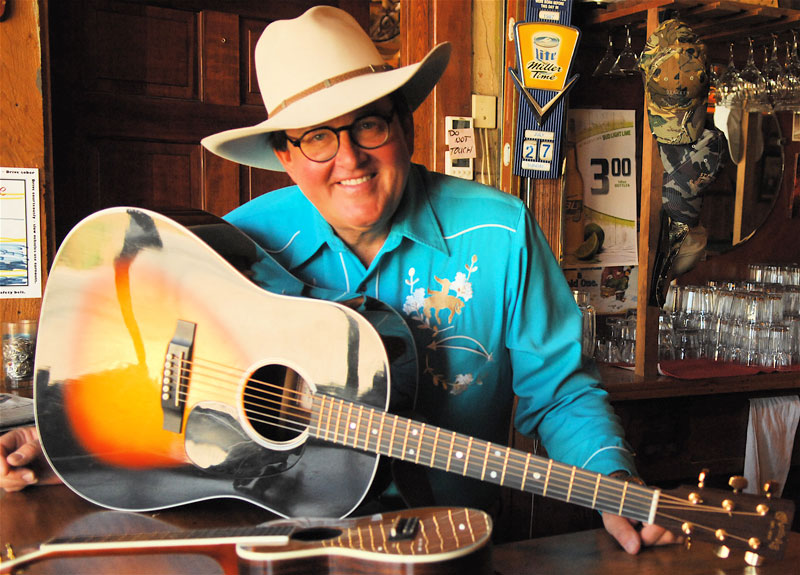
This week, our guests are Jim Salestrom, an internationally known, Emmy Award-winning musician who uses his gifts to bring people together, share talents and motivate everyone to be their best - and - Jeff Wasden, a Denver businessman and President of the Colorado Business Roundtable. Jeff has an incredible talent for gathering people together, identifying their strengths and encouraging everyone to work together. Each of them will be contributing editors here on ICOSAMedia.com. Jim Salestrom will contribute stories about music and entertainment and Jeff Wasden will share stories related to business and politics. Look for their stories here weekly.
Additionally, Jim and Jeff are working together to further the mission of the Colorado Business Roundtable, to bring business leaders together to accomplish more for the state of Colorado and for business enterprise.
Just as Jim's musical talent brings people together, and provides a shared experience, the Colorado Business Roundtable seeks to bring people together for a shared purpose and to enrich each person's, each business, each enterprises experience.
Tune in Saturday at 10:00 AM on KNUS 710 - to learn more about the Colorado Business Roundtable.
Please let us know what you think of our program, either by commenting here or on Facebook at Connect & Collaborate with ICOSA or join the discussion on Twitter @ICOSAMagazine.
2014 Adobe Creative Cloud Launched Today
Today Adobe announced the 2014 Creative Cloud, which included faster production options and new tools, such as the Creative Cloud pen. Technology has changed the face of art. The computer as a tool opens up where, who and how you work. Experimenting with new software allows you to do that. To see what you missed in the keynote address click here.
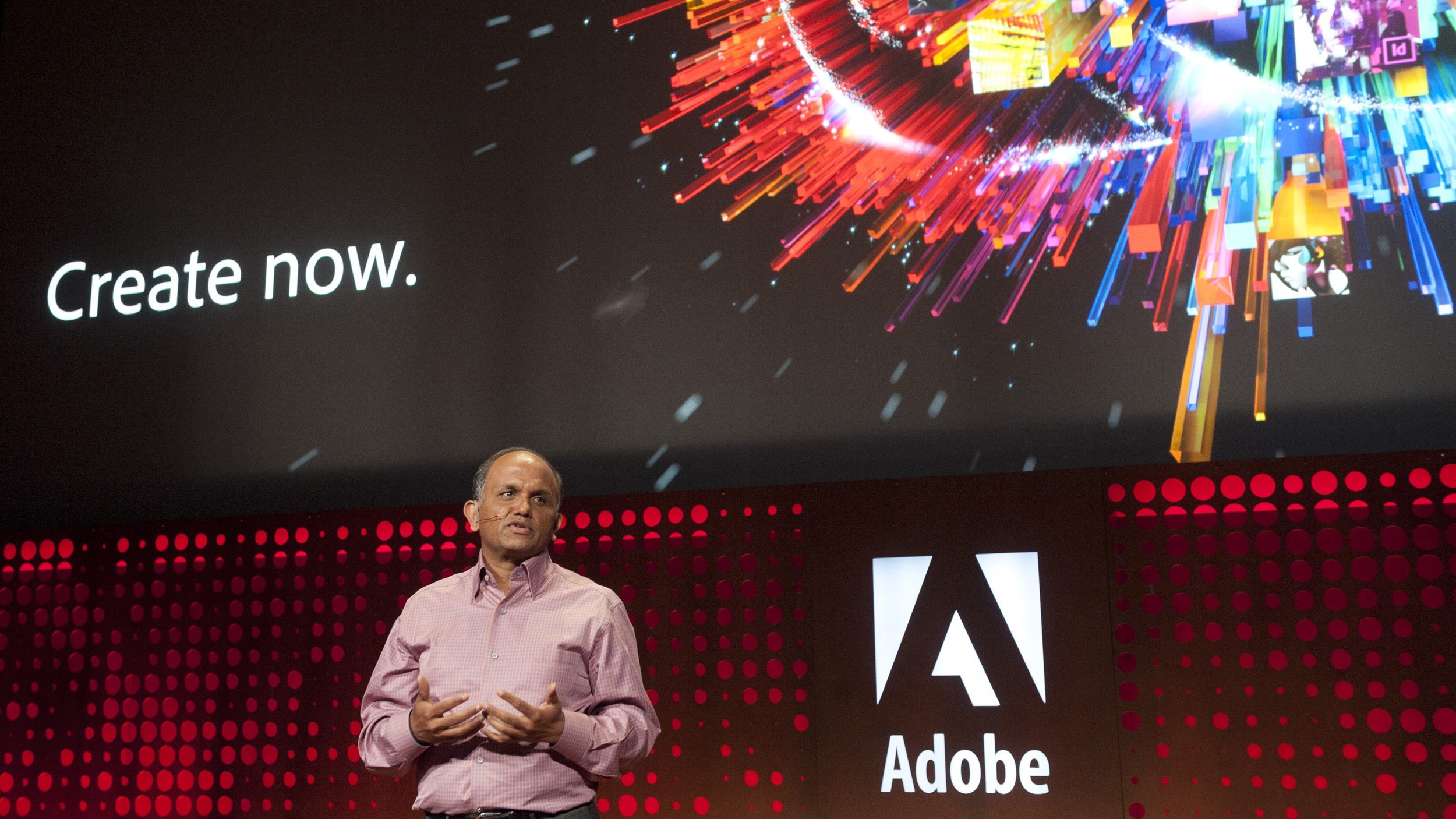
Adobe CEO, Shantanu Narayen spoke today in NYC. He is most excited about, “all the cool innovation that is worked on all around the world every day.” Adobe aimed to re-imagine how creatives will work with CC in the future. CC is updated every 12 to 18 months, with that product lifecycle Adobe is showing constant engagement with their customers.
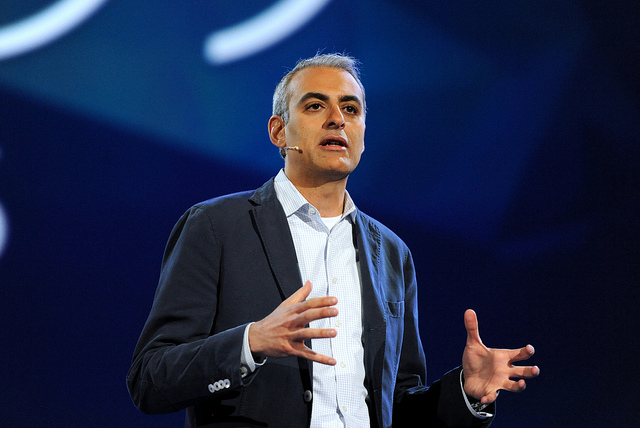
Digital Media SVP David Wadhwani has spent 12 years at Adobe, and was super excited to walk through new products today. The next frontier for Adobe is experience. Wadhwani says ¾ of creative are working beyond one medium. Optimism is one thing Adobe says they see as a trend in creatives; however work is expected to be completed faster and is more complex. Adobe wants to help creative meet those demands.
The Creative Cloud Pen lets you draw without needing to carry several colors and pencil sizes. It also links to the Creative Cloud, lets you bring in your settings, keep a clipboard and share work with your network. Sketch, Ink, Line, and Slide are tools to use with the pen. Ink and Slide are available today on adobe.com. The pen sells for $199.99, and is sold by Adobe’s partner Adonit.
Lunch Lady Blues
The National School Lunch Program (NSLP) began in 1946 during Harry Truman’s presidency. The purpose was to reduce nutritional deficiencies in the enlisting military as a “measure of national security”. After all, you can’t have a robust military when those enlisting aren’t well enough to even qualify. Things have changed over the decades. I’m sorry Mr. President, but lunch isn’t what it used to be. I was on the lunch program as a child. Lunch consisted of a featured food, fruit, a vegetable, and milk. I hit the high life when my middle school included a salad bar! Upon entry into high school, however, I saw a new trend emerge. Instead of a cafeteria, the school had booths that served burgers and fries. And it wasn’t cheap, which was incentive enough for me to bag my own lunch. Nowadays, foods that were once made from scratch have now been replaced with Pizza Hut and Taco Bell. What happened?
In an effort to increase student participation in the lunch program, schools enlisted the help of familiar fast food companies. As the popularity of this trend grew, so did student waistlines. Once this trend established itself, schools no longer needed cooking equipment so they were removed. As the quality of food has declined, so too has academic performance in many schools. A 2010 study of 34 countries showed that we ranked poorly particularly in math and science.
On an episode of Anthony Bourdain’s Parts Unknown, they visit an elementary school in Lyon France, where the chef spends less per child than the average American elementary school, only these kids aren’t eating processed, preformed, packaged food. Food is served on plates rather than Styrofoam trays. Everything is made from scratch and the only beverages are milk and water. The featured lunch was pumpkin soup, fresh salad greens, homemade crème fromage blanc with chocolate and orange slices for dessert. The kids were ravenously enjoying several helpings of soup…something rather unheard of in the U.S. What a wonderful experience to be exposed to such culinary diversity at that age!
Watching the children’s demeanor on the show was revealing. These were bright-eyed, inquisitive and focused children that weren’t hyperactive, overstimulated, or misbehaved. Considering the number of cases in the US of children with ADD and behavioral issues, one might wonder if malnutrition is to blame. A paper written by Rita Rausch is a study on how junk food or unbalanced diet affects brain function.
Is the key component to unlocking the potential of brilliant young minds within what they’re being fed? If this is indeed the case, perhaps it’s high time we revisit the lunch program with new vigor and bring back our lunch lady.
Susan Cain’s Introvert Revolution
I do my best work sitting in the ICOSA Radio room. I get my work done quicker, and work simply flows easier. Retreating to solitude is my way to focus and since the room is fitted with sound proofing it’s quiet without distractions. Today, I found some sound evidence on why this is more than just a preference.
Susan Cain author of, “Quiet: The Power of Introverts in a World That Can’t Stop Talking,” is starting a revolution that will empower introverts, for the benefit of us all. One in every two or three people is introverted, so belonging to a society that encourages extroversion creates challenges for one third of the population.
Susan Cain spoke at TED in 2012 about the need of recognition, understanding and advancement of introverts. Being introverted doesn’t equate to shyness, rather it is how a person reacts to stimulation. Cain further explains that, “We need more of a yin and yang between these two types. This is especially important when it comes to creativity and to productivity, because when psychologists look at the lives of the most creative people, what they find are people who are very good at exchanging ideas and advancing ideas, but who also have a serious streak of introversion in them. And this is because solitude is a crucial ingredient often to creativity.”
At the All-Stars session 5 at TED 2014 Cain shared her plan of action—the introvert revolution. Cain has developed a series of programs and tools coined; QuietTV, Quiet Leadership and Supporting Quiet Children.
TED’s Blog describes Susan Cain’s plan:
QuietTV A website that will eventually host a web-based TV series with profiles and interviews of famous introverts, highlighting how introversion shaped the way they contribute to the world. The site will roll out as the movement gathers momentum, but if you want to learn more now, check out Cain’s author site, The Power of Introverts. Quiet Leadership This program, headed by West Point professor Mike Erwin, will center on identifying and strengthening the leadership style of introverts. Though Erwin is himself an extrovert – he talks a mile a minute, according to Cain — he observed during his time in combat that introverts make great leaders if they can identify their strengths. The leadership training will offer examples of powerful quiet leadership, and will draw on the latest research on managerial styles. Supporting quiet children
“This is the area that is closest of all to my heart,” said Cain. “I’ve seen first hand in the wake of my TED Talk that there’s such an enormous need for parents and teachers to better understand how to love and cultivate the introverted kid.” Like the Quiet Leadership program, this program is in its infancy, but will eventually provide tools for teachers and parents to support quiet children as they grow into themselves. Cain is in the process of identifying partner schools across the country that will collaborate in developing the training program.
Clinicas: Continuing the Conversation in Mexico
In the summer of 2013, Denver played host to the Biennial of the Americas, which is a celebration on art, culture, dialogue and ideas for countries in the western hemisphere. At the 2013 event many countries were represented in day-long clinicas and symposiums to address topics that affects all countries. The Biennial of the Americas describes clinicas as “a diverse and innovative gathering of leaders from across the Americas will participate in a series of facilitated, peer-to-peer workshops called clinicas. Clinicas are unique to the Biennial of the Americas experience as they offer a select group of invited specialists in their field the opportunity to interact with other innovative though leaders on a variety of topics.” The invite-only attendees discussed in an open dialogue issues such as environment and public health, water, energy, innovation, conscious business practices, education, technology, and the new normal.
The viewpoints from the morning clinicas were then reported out to a public audience in the evening while the content was used to drive the panel discussions.
The education conversation has recently continued in Mexico City during the trademission this week with Governor John Hickenlooper and various leaders from Colorado. The clinica topic of education was discussed with greater in-depth analysis of physics, soft skills, scale and socioeconomic issues and workforce development. The next clinica coversation is on energy and will take place during the week-long trademission.
Photo Credit: The Biennial @thebiennial
$400,000 Creatively Made $4 Million In Additional Revenue
The Cannes Lions International Festival of Creativity runs till the 21st of June. “Guilt Trips” took the Grand Prix award today for Creative Effectiveness. This witty commercial exponentially increased the ticket sales for the V Line train in Melbourne, Australia.
A Brief Explanation provided by Cannes Lions: This is a story about how V/Line used the extraordinary power of guilt to motivate young Victorians to leave the bright lights of the city to visit friends and family in the country, all with a tiny budget (US$400,000). When running a train company, it’s normal for trains to be at or near capacity during peak periods. The trains hardest to fill are those travelling against commuter traffic and those in the middle of the day. V/Line calls these customers its “Visiting Friends and Families”. They represent a potentially huge opportunity if they can be captured, but they are difficult to isolate and as V/Line discovered, even harder to motivate.
Young Victorians were fleeing rural towns for the big city, and put simply, they were just too busy with their new lives to visit friends and relatives back home in the country. And they felt guilty. They felt they were neglecting their friends and family back in the country. But as a train company we couldn’t make people feel guilty. But we could create a new product to advertise – The Guilt Trip, a pre-purchase ticket that people could send to someone who would feel guilty for not visiting. Through this, we used the power of guilt to get people back to the country.
To sell our product, there were three parts: 1. Tell Victorians about our new product, The Guilt Trip: We used traditional media and public relations to kick off the campaign. 2. Get country people to do the selling for us. To empower friends and family to ply on the guilt. Online films, regional media and Guilt Trip handbooks offering tips on how to ply guilt. 3. Use social media to enhance the guilt. The Guilt Trip platform was designed to allow users to publicly guilt their family and friends to come home – through Facebook and Twitter (Image 6).
The Results. We saw a 12% increase in off-peak sales with an additional 123,000 tickets sold, smashing our 5% kpi. Guilt Trips generated $4 Million in additional revenue; exceeding our KPI by 167%. Consideration also increased with call-center enquiries for VFR travel rising on average 28%, well exceeding our 10% target. This campaign helped more V/Line employees to realize that they do not simply drive trains; they help to bring loved ones back home to their families, their friends and their country towns. One Guilt Trip at a time.
Rural Town Versus Twin Twisters
Pilger, Nebraska didn't stand a chance against twin tornadoes that barreled across the plains and right through the small town on June 16th. With a population of 378, it's the sort of small, country town with probably two square blocks of century-old store fronts, and as many bars as there are churches, say two or three of each. In communities like this, people are close. You can't help but know everyone else in the area, and as townspeople took shelter they all, likely had a fairly good idea where everyone they knew was. As Gene Oswald, a nearby farmer told an Omaha World Herald reporter about taking shelter in a relative's basement with his nephew, who at one point peeked out a window and told Oswald, "Gene, there’s stuff flying above the co-op,”. Surely both men had an idea which friends and neighbors were taking shelter at the co-op. Five co-workers were huddled in the co-op office’s vault. Others were safe in the meat locker of the Pilger Store next door.
Meanwhile, this funnel was cutting a swath, heading straight into town. As I watch the video of the tornado crossing land that is very familiar to me (my family farm is about an hour north of Pilger) I remain detached until I see the water tower hover above the trees that surround the small town, and suddenly tears flow. The water tower makes it real, as it indicates that there's a community nestled among the trees you see from highway.
Here's an Omaha World Herald slide show of the damage in Pilger.
That's what community looks like on the open plains of Nebraska. Trees point to where people have gathered. There were few trees on the plains until people planted them. You can see for miles across the open prairie, with nothing impeding your view. Just miles of corn rows, alfalfa fields and pasture lands. It's stunningly beautiful. God's country.
So when I clicked through comments accompanying a news report of the Pilger tornado, and read random bits of outrage from fellow Americans, questioning why anyone would live where a tornado could wipe everything out, well, I got a little spun up.
We can pose that question to any area of the country. Why would anyone live where hurricanes hit? Or build a city below sea level (New Orleans, I'm looking at you.) Why would anyone live where there are earthquakes, landslides or floods? People are afraid of the unfamiliar. The thought of a hurricane is more terrifying to me than a tornado. Hurricanes cover more square miles, and the damage can extend for miles from the eye of the storm. Where I'm from, tornadoes are familiar, and random enough to rarely seem like an omnipresent threat to any one person.
The fact is, in the 50 years that my parents have lived on our family farm, not a single tornado has hit it, or touched down within ten miles of our property. As far as I know, we can say the same for the fifty years my grandparents lived on the same land. Building a home, and life and a livelihood in our little corner of Nebraska has been a good risk for the past 100 years.
Why would anyone live in the states frequently stricken with tornadoes? I'll tell you, it's for the time in between tornadoes. For the endless blue skies that meet at the horizon with endless prairie. The pleasure of seeing miles upon miles of fields of the deepest green sweet corn, and how it dances in a breeze. To crest a hill to see a handful of strong, beautiful quarter horses running to the fence line. To walk down a country lane, during a warm summer rain.
True, I left Nebraska for Colorado, where the cold isn't as bitter, mosquitoes are less populous, and where hay fever can't make me miserable. It wasn't that tornadoes that drove me away.
We all love something about where we live. When a horrific natural disaster strikes, we need to support each other through it. Not criticize an entire state as uninhabitable. We need to feel grief for the lives lost, in this case two lives, a five-year-old girl and a motorist. Now is the time to pull together to help a town recover.
Starbucks Offers College Perks
It's safe to say that Starbucks may suddenly be inundated with job applications. Starbucks billionaire Howard Schultz just changed the game in the world of part-time and minimum wage jobs versus getting an education. On June 16th, Schultz announced that his company would pay for thousands of their workers to earn a bachelor's degree through Arizona State University's online degree program.
While other employers are engaged in the debate over raising the minimum wage to help part-time employee's bottom line, Starbucks is offering a different solution. Starbucks was already one of the first corporations to offer part-time employees health benefits, 401k and a stock equity reward program. By adding the College Achievement Plan, the company is bridging the gap for employees with career ambitions.
It may look like a move made simply to promote a good image, but Schultz says, "I couldn’t care less about marketing,” he said. “This is not about PR. This is about the future of our company doing what’s right for our people and also, sending a message to the country that we can’t build a great company and we can’t build a great enduring country if we’re constantly leaving people behind."
The plan appears to have been formed with the full knowledge that employees will move on once they complete a degree, and they'll see that as predictable employee turn-over, typical for retail jobs. The employees will not be contracted in any way to stay with Starbucks upon graduation.
Schultz frames this offering as a response to the main obstacles of higher education, specifically the challenge of work/life balance, and the fact that college simply isn't affordable for most workers. Starbucks will provide working students with a dedicated enrollment coach, financial aid counselor and academic advisor to support them through graduation.
Could more employers afford to offer this perk and incentive? Make no mistake, tuition is tax deductible, even if a corporation is paying for it. So Starbucks will see some benefit beyond creating an educated workforce.
Now the question is whether we really believe a bachelors degree is the answer for every retail employee? If every Starbucks employee who wanted to, was able get a college degree, will there be employment opportunities for them when they graduate? Or do you feel better about being underemployed if you didn't have to pay tuition yourself?
Alternatively, if Starbucks is helping send it's employees to school, we can all feel a little better about spending four bucks on a frou-frou drink, if we feel like we're contributing to a greater good in some way.
Read the full scoop on Starbucks webpage here.
photo credit : http://fivegreatest.com
Colorado Leaders Create Collaborative Dialogue with Mexico
Today, Gayle Dendinger, CEO of ICOSA Media will join Colorado Governor John Hickenlooper and seventy other various leaders from Colorado businesses on the Biennial of the Americas trade mission to Mexico City. This four day trade mission is sponsored by the Colorado Office of Economic Development and International Trade and is meant to build ideas, connections and a collaborative dialogue for the upcoming Biennial of the Americas to be held in Colorado in 2015. Participants include Anadarko Petroleum Corporation, Museum of Contemporary Art, Gill Foundation, Urban Market Partners, Colorado State University, CH2M Hill, Bravo! Vail, Vail Resorts Inc., Denver Museum of Nature and Science, CIMCO Private Wealth, Colorado School of Mines, Unreasonable Institute, ICOSA Media, Denver Hispanic Chamber, Project C.U.R.E., Chamber of the Americas, Lockheed Martin, Colorado College, Denver International Airport, Smithsonian, Suncor, Colorado State University…just to name a few.
“The Biennial of the Americas provides an international platform for leaders in business, government, civil society, and the arts to examine the significant issues impacting life in the Americas.” For more information on the Biennial please visit, www.biennialoftheamericas.org.
To view coverage of the 2014 Biennial of the Americas please visit, http://bit.ly/B_A Participants will arrive this afternoon into Mexico City and will start the evening with a welcome reception hosted by Vail Resorts that will include leaders from Colorado and Mexico City.
Photo credit: www.luc.edu

